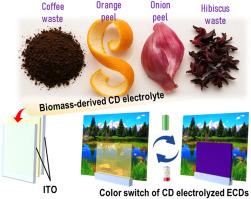生物质废弃物碳点作为电致变色器件可见光-近红外调制可持续电解质的合成与综合评价
IF 6.3
2区 材料科学
Q2 ENERGY & FUELS
引用次数: 0
摘要
碳点(CDs)作为电致变色器件(ECDs)的电极和电解质改性剂,在促进氧化还原反应方面表现出了突出的能力。然而,尽管生物质来源的碳点具有低毒性、低成本、固有掺杂和高稳定性等优点,但尽管存在各种合成方法和来源,但对其的探索仍然不足。在此,我们报道了用简单的自下而上方法从咖啡渣(CWCD)、橘子皮(ORCD)、木芙蓉花(HICD)和红洋葱皮(ROCD)中制备的碳点具有优异的电解活性。丰富的表面功能位点和平衡良好的sp2-碳结构域使ECDs具有优异的离子电导率,从而产生令人印象深刻的颜色切换性能。橘子皮碳点(ORCD)在所有样品中表现出最高的性能。在可见光和近红外(NIR)区域,在6 s内分别获得了94.9%和92.6%的高光学对比度(ΔT)。此外,其显色效率(CE)高达150 cm2C-1,与其他已报道的电解质材料相当甚至更高。循环伏安法证实了紫红素具有完全可逆的氧化还原活性,而电化学阻抗谱显示ORCD具有最低的电荷转移电阻。此外,所有设备都表现出超过500次循环的鲁棒循环稳定性。这些结果突出了生物质衍生的CDs,特别是ORCD,作为高性能和可持续电致变色应用的高效电解质材料的潜力。本文章由计算机程序翻译,如有差异,请以英文原文为准。

Synthesis and comprehensive evaluation of waste biomass-derived carbon dots as sustainable electrolytes for Vis-NIR modulation of electrochromic devices
Carbon dots (CDs) have demonstrated outstanding capability in enhancing redox reactions as both electrode and electrolyte modifiers in electrochromic devices (ECDs). However, although biomass-derived carbon dots provide low toxicity, low cost, intrinsic doping, and high stability, they remain insufficiently explored despite the existence of various synthesis methods and sources. Herein, we report the excellent electrolytic activity of carbon dots from coffee waste (CWCD), orange peel (ORCD), spent hibiscus flower (HICD), and red onion peel (ROCD) prepared via a simple bottom-up method. Rich surface functional sites and well-balanced sp2-carbon domains enabled excellent ionic conductivity in the ECDs, resulting in impressive color switching performance. The carbon dot derived from orange peels (ORCD) exhibited the highest performance among all samples. A high optical contrast (ΔT) of 94.9 % and 92.6 % was obtained under 6 s in the visible and near infrared (NIR) region, respectively. In addition, it exhibits a high coloration efficiency (CE) of 150 cm2C-1, which is comparable to and even higher than other reported electrolyte materials. Cyclic voltammetry confirmed complete and reversible redox activity of the viologen species, while electrochemical impedance spectroscopy revealed that ORCD had the lowest charge transfer resistance. Additionally, all devices demonstrated robust cyclic stability over 500 cycles. These results highlight the potential of biomass-derived CDs, particularly ORCD, as efficient electrolyte materials for high-performance and sustainable electrochromic applications.
求助全文
通过发布文献求助,成功后即可免费获取论文全文。
去求助
来源期刊

Solar Energy Materials and Solar Cells
工程技术-材料科学:综合
CiteScore
12.60
自引率
11.60%
发文量
513
审稿时长
47 days
期刊介绍:
Solar Energy Materials & Solar Cells is intended as a vehicle for the dissemination of research results on materials science and technology related to photovoltaic, photothermal and photoelectrochemical solar energy conversion. Materials science is taken in the broadest possible sense and encompasses physics, chemistry, optics, materials fabrication and analysis for all types of materials.
 求助内容:
求助内容: 应助结果提醒方式:
应助结果提醒方式:


